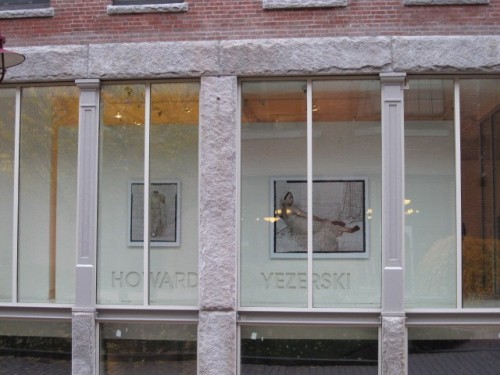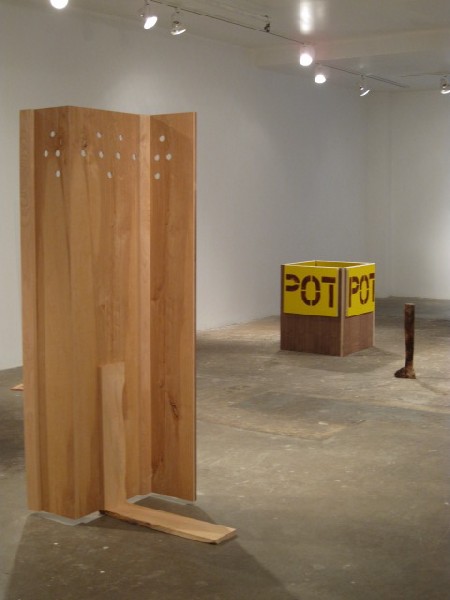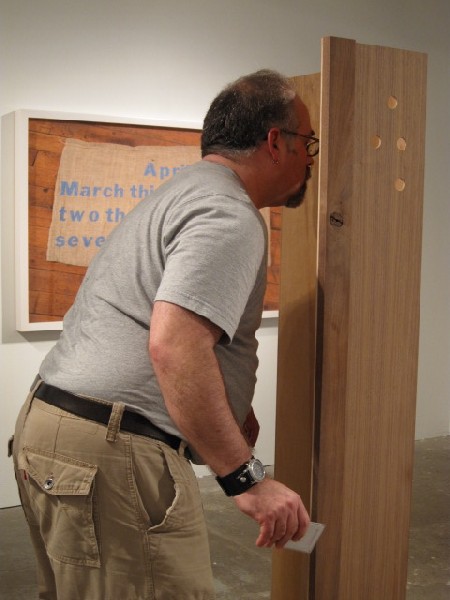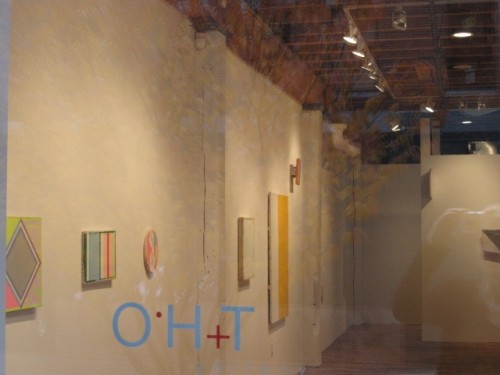Boston's SOWA Galleries
Reshuffling the South End and Harrison Avenue
By: Shawn Hill - Nov 11, 2008
After a summer of closings, openings and relocations, the galleries at 450 Harrison Avenue and their neighbors (the now bustling SOuth of WAshington St. edge of the South End) SOWA offer refreshed and reconfigured faces for the upcoming holiday season.
Like an old friend who's gone under the knife, you can tell there's been work done, but the scars are healing and a newly optimistic stability is asserting itself.
After a bustling First Friday on November 7th, gallerists and artists seemed cheered and upbeat the next day during my visit. Anxieties about the economy persist, but the recent landside Presidential election has unleashed a jubilant mood. The outcome came as a surprise, even though, as dealer Howard Yezerski explained, he's always felt that all involved in the art world necessarily have a touch of the Quixotic about them. He asserts that even as we "tilt at windmills, we never give up hope."
Yezerski's new space is an emblem of such long-term persistence. It's the fourth space I've followed this gallery to since beginning to write about the art world back in 1990, when South St. was Yezerski's home. The trek to South St. through Chinatown was actually an easier one than reaching SOWA can be, but that space was a long and window-less one on an upper story, off a cramped stairwell. His two homes on Newbury St. offered different advantages, but none had quite the expansiveness of the wall of windows fronting this new space.
"It's deceptively large," Yezerski admitted, as the windows make the two, modest, exhibition rooms within look larger than they are from the street. A third space, as yet unfinished, will be the office, and in today's mood of complete disclosure, it's almost in the window like a store display. The owner's presence and the gallery business will always be transparent to visitors.
Yezerski inaugurates his new space with the work of an old friend, Lalla Essaydi, in an installation of tapestries and video that provides a glance back to her earliest work from nearly a decade ago. As always, Essaydi is concerned with the place of writing and gender identity in the East.
Across the street, Carroll and Sons takes a similar hands-on presence in their reception desk design, but behind this public office/vestibule are several distinctive exhibition rooms. The Boston Drawing Project is still housed in this former Bernard Toale Gallery space, but the stable of artists and the art fair mood of several simultaneous competing show-pieces reflect the flair of director Joe Carroll. A smaller, more DIY version of Toale's gallery persists in an adjacent space.
Carroll and Sons features several shows this month, from gestural graffiti with "Indelible" marking pens by Julia Featheringill to Ambreen Butt's subtle and anxious prints that explore tensions between ancient mythology and current warfare in the newly opened back room. Carroll is adept at providing a tailored environment for each body of work.
Down the row, Arlette Kayafas has taken over an expansive new space. Totally redesigning the interior layout from the previous gallery, she too has set up distinct spaces to house at least three if not more shows simultaneously. The pale (but not cold) gray walls and exposed venting of the room seem inviting and frank, providing a calming and spacious viewing environment for the diverse array of photographers Kayafas ceaselessly locates. This month we see giddy photos of a child-proofed and friendly home by Robert Knight, a selection of black and white suburban facades by Bruce Myren, and a charming room full of off-key and unexpected vistas of Italy.
Adjacent to the old Kayafas space on the lower level, Samson Projects continues to provide a bare bones and informal setting for lively experimental work. This month features the latest conceptual sculpture of Taylor Davis. This show is as bold and daring as we are used to from the former ICA Prizewinner. Davis continues her minimal and contrapuntal responses to the human body in wood, this time mixing in paintings and photos as surprising new flavors with perfectly cut and arranged wooden planks.
At Bromfield Gallery, expressionist painter Phillip Gerstein has a strong show of new works in the middle gallery. His frenetic spreads of marks in unusual color choices on fields of battle-ship gray and white are meant to be read as responses to the poetry of e.e. cummings.
Equally painterly is the vibrant show of abstract works at O'H+T, occupying the corner gallery in the same busy façade. Gallerists Kathleen O'Hara and Caroline Taggart have arranged a strong collection of geometric but rough-hewn and handmade abstract paintings in luscious rich colors for "Fabrications." Matthew Rich's cut paper pieces are especially vibrant, but the whole show is a refreshing look at hand-made, object-oriented abstraction.
The co-directors were hard at work on their laptops during my visit, busily planning their next trip to the Aqua Art/Miami art fair in December. Art fairs have taken on an increased prominence in both selling work and securing a place in an international art network, and O'H+T evinces the practical flair of survivors who are intent on maintaining a local showplace for art with integrity.
With so many shifts, expansions and renewals taking place on the frontier of Boston art, one wonders how the Newbury St. galleries are doing. There a mix of stalwarts and survivors carry on, who will be visited in a future column.











